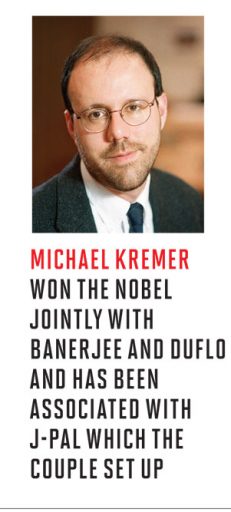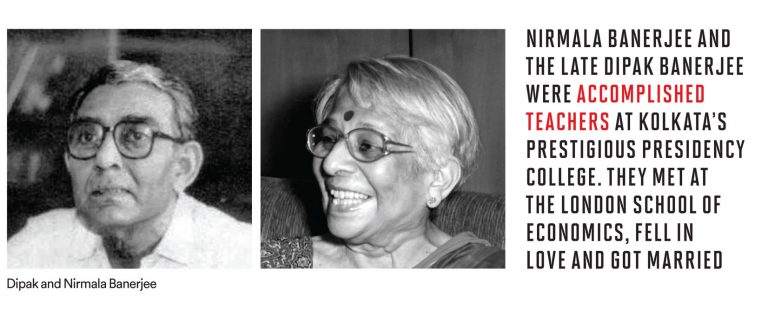The Grand Experimenters
Nobel laureate Abhijit Banerjee and his team of economists started a quiet revolution to free people from poverty traps
 Siddharth Singh and Ullekh NP
Siddharth Singh and Ullekh NP
 Siddharth Singh and Ullekh NP
|
18 Oct, 2019
Siddharth Singh and Ullekh NP
|
18 Oct, 2019
/wp-content/uploads/2019/10/Nobelwinners1.jpg)
Abhijit Banerjee and Esther Duflo (Photo: Raul Irani and Getty Images)
AS A YOUNG CHILD, my son Abhijit liked literature and poetry and read extensively in Bengali and English. My memories of him from his early teens are of a voracious reader,” Nirmala Banerjee tells Open before ending the chat on a polite note. “The only thing I want to say is I am happy like any other mother about her son’s achievements. I am thrilled,” says this former economics professor at Kolkata’s prestigious Presidency College where her husband, the late Dipak Banerjee, was also a celebrated member and head of the economics faculty—they had met at the London School of Economics, fell in love and got married. The Kolkata-based 83-year-old mother of Banerjee says she realised her bibliophile son’s bent for economics only much later because, after all, he chose to study the subject by mere accident. Banerjee Junior disliked travelling far from home on a daily basis to the Indian Statistical Institute on BT Road in the city to study maths and therefore decided to join an institution closer home—to study economics at Presidency College, also the alma mater of his illustrious predecessor Amartya Sen, the only Indian before him to win the Nobel Memorial Prize in Economic Sciences and who knew him as a toddler.
Aniruddha Banerjee remembers his elder brother, who has won the coveted prize in economics along with ace economists and collaborators Esther Duflo and Michael Kremer, as highly skilled in maths from a young age, making it immensely helpful for him in solving tough problems ahead of school exams. It is said that even his father, the much-respected academic who had also taught briefly at the University of California, Berkeley, used to fall back on the young Banerjee, an undergraduate at Presidency, whenever he ran into difficult mathematical sums while taking classes.
Writes TK Arun of The Economic Times who was a year senior to Banerjee at Jawaharlal Nehru University’s (JNU) economics department, ‘Abhijit was quantitatively gifted. Maths runs through economics in general. One course, taught by Prof Anjan Mukherjee, Linear Economic Models, was high-level mathematics adulterated with a smattering of economics, and had a textbook by David Gale that contained abstruse algebra and tough exercises to solve. The solution to one problem had proved elusive after much struggle inside the library, till it suddenly chose to offer itself up as an epiphany in the middle of polishing off some French toast at the canteen. The satisfaction this offered had to shed its smugness when it turned out Abhijit had worked that problem out in his head.’
Aniruddha, who is four-and-a-half-years younger, says he has always looked up to his brainiac brother and that they still bond like teenagers. In fact, he spoke to his ‘dada’ (others at home call Banerjee Jhima) hours after the Swedish Academy announced this year’s winners of the Economics Nobel, also known as the Sveriges Riksbank Prize in Economic Sciences in Memory of Alfred Nobel, but all that the brothers did was poke fun at each other in a fraternal display of unrestrained joviality. “We did not talk about the Nobel Prize at all. We were busy talking about other things,” laughs Aniruddha, an advertising pro and co-founder of Gurugram-based brand strategy consultant Expereal, who adds that he is totally enamoured of his elder brother’s culinary skills. “He began cooking when he went to Harvard University to do his PhD. He felt he was not able to eat what he wanted to and picked up cooking. He has a flair for it. He has a global, cosmopolitan outlook towards cooking,” he avers. “Abhijit can dish out any kind of food on the table. Which is why I say he should try winning the MasterChef competition next,” exclaims Aniruddha who loves travelling with his brother since the economist chooses places to stay where they can also cook. “We holiday around the world; some of the places that come to my mind are Corsica, Sri Lanka, south of France [from where Duflo hails], Phuket and so on, besides many destinations within India. Anywhere in the world, dada does the shopping [for food to cook] on his own and he makes mouthwatering dishes while talking to people, making the whole exercise look extremely easy.” The brothers are also into music, especially Hindustani classical, and can sit back and chill together for hours.
Banerjee’s JNU roommate and former RBI official G Sreekumar confirms the Nobel laureate’s love for Hindi songs. Sreekumar tells Open that when they joined JNU in 1981, it had two campuses, referred to as ‘up’ and ‘down’. The former is where it is located now and the latter, where first-year MA students had their hostel, unofficially called Narmada. Banerjee, he and another friend Manoj Pandey shared room number 511 for a year in Narmada and he can’t keep count of how many times they went to music concerts in the city and film shows at embassies and film festivals. He recalls that one of Banerjee’s favourite Hindi songs—that Pandey often sung for them—was Kishore Kumar’s Aa chal ke tujhe main le ke chaloon. “I feel that it is a metaphor for the work he has done,” notes Sreekumar, emphasising that the Banerjee he knows is deeply committed to his work. “He is extremely passionate about his work. It is as if he is genetically predisposed to working for the cause of the poor,” says Sreekumar, who wrote in The Economic Times that Banerjee had scored 8A+s, 6As and 2A-s in his MA class, which made him one of the highest scorers ever in JNU’s Centre for Economic Studies and Planning. Banerjee, who was instrumental in drafting a welfare scheme for the Congress ahead of the 2019 polls, was not associated with any organised political outfit, reminisces Sreekumar, on an otherwise politically charged campus, yet he chose to be part of an agitation in the early-1980s that landed him in Tihar jail. Which is why his contemporaries now joke about him being the first Tihar inmate to win a Nobel Prize!
The story of the three Nobel laureates in economics and their achievements is best told through the long journey of development economics in the 20th century. The idea was simple enough: the ‘new’ countries—a euphemism for the decolonised nations of the mid-20th century—had a set of common characteristics. They were backward and poor; had fast-growing populations; were usually endowed with good natural resources. What they needed was a new set of ideas beyond the tired paradigm of markets.

In the bargain, these new countries received a slew of experts from Western institutions and universities. This was a new breed of economists who called themselves ‘development economists’. They were the virtual who’s who of the economics world at that time. India, for example, received advice from Nicholas Kaldor, Albert Hirschman and Ragnar Nurkse who wrote about India’s planning process. There were a host of others, including Milton Friedman, who had a different take on what the country needed. The consensus was that high growth was essential to end poverty and that required the government to play a key role in coordinating various investment activities required for growth. This task was considered beyond the abilities of the private sector.
That consensus remained in place for nearly three decades before cracks began appearing. It was a top-down approach in which it was assumed that fast growth would automatically lead to a reduction and, over time, elimination of poverty. Indian planners, for example, did not begin addressing the question of poverty until quite some time after the planning exercise began. After three decades, India did not see a sufficiently high tempo of growth and there certainly were not many resources available for poverty alleviation.
So what happened to development economists? Nobel laureate Paul Krugman once described what happened to them: ‘Along with some others, notably [Gunnar] Myrdal, Hirschman didn’t wait for intellectual exile: he proudly gathered up his followers and led them into the wilderness himself. Unfortunately, they perished there.’ What Krugman said about Hirschman made a larger point: these economists had what are today called ‘hand-waving arguments’. They could not build sophisticated models that could give insights into the growth and development process. By the 1980s, the tide had turned against statist thinking. Liberalisation and globalisation provided unprecedented economic opportunities to erstwhile poor countries and they reaped the gains quickly. In 1990, globally, 1.85 billion poor people lived on less than $1.90 per day. By 2015, this number had fallen to 736 million, a massive reduction by any measure.
Even as this progress was being made, development economics as a subject fell out of favour among mainstream economists. To be sure, there were heterodox schools of economists who continued the earlier tradition but with much diminished interest in the subdiscipline overall. The magic of the 1990s was largely a game of conservative macroeconomists and trade theorists.
By the turn of the new century, development economics was back with a bang. But this time with a wholly different flavour. Unlike the past, the new approach, exemplified by the work of Banerjee, Duflo and Kremer, looked at development issues at a micro-level. The trio asked questions about healthcare, microfinance, education and a host of other themes from the ground upward. For example, do women politicians lead to better provision of water supply in villages? Do deworming medicines improve children’s attendance in rural schools? Do contract teachers do a better job in educational outcomes as compared with permanent government teachers?

Much of the rigour and success of the new development approach is based on Randomised Controlled Trials (RCTs). The idea, originally used in medical experiments, is simple enough. Two randomly selected groups are treated differently. For example, one group, say, a set of school-children, may be given a deworming medicine, while the other is not. Then the results of the two groups are compared. In this way, cause and effect, the key to any scientific understanding, are isolated in a rigorous fashion. This has revolutionised our understanding of economic processes at the micro-level. It has also paved the way for policy interventions at a level based on evidence.
There are, however, intellectual critiques of this method that are at the centre of J-PAL’s activities. J-PAL is short for The Abdul Latif Jameel Poverty Action Lab, launched in 2003 by Banerjee and
Duflo and with which Kremer has had a long association. The lab is named after the late Saudi business tycoon Sheikh Abdul Latif Jameel and funded majorly by his MIT alumnus-son Mohammed. Duflo, 46, and Banerjee, 58, meanwhile, are partners in life as they are in work—and that makes them the sixth couple to win the Nobel. Banerjee was Duflo’s doctoral advisor at MIT in the late-1990s and they began to date later. “I remember them as co-researchers from some 20 years ago,” says Sreekumar, speaking of his meeting with Duflo in Mumbai where the duo had come visiting for poverty studies in collaboration with a corporate firm. Banerjee, who was earlier married to Arundhati Tuli Banerjee of MIT, had a son from the first marriage who is no more. Today, Abhijit and Duflo have two children, a girl and a boy, Noemie, 5, and Milan, 7, respectively. Duflo, the second woman to win the Nobel Prize in Economics, told the Associated Press that her kids “believe they are the centre of the universe and they don’t accept kitchen table conversation” about weighty matters like economics. The couple are close friends with Kremer, the third recipient, who also visited Banerjee’s family home in Kolkata some years ago.
Even before the three economists were awarded the Nobel Prize, there had been murmurs of disagreement on the applicability of their methodology in drawing policy conclusions. To give one example based on an influential study by Duflo and another colleague, a study based on data from India asked if having an elected woman leader to head a local government made a difference to the quality of life in the village or locality. For example, there is a positive correlation between having women leaders and the quality of provision of public goods, such as water. But cause and effect can run either way: It might be that women leaders are better at providing water supply or that in villages that have better water supply, women are freed from the burden of fetching water and thus have the time and resources to run for public office.
The Duflo study ruled out the second possibility and thus concluded that women leaders are indeed better at providing public goods. This has, however, been criticised by Kaushik Basu, India’s former Chief Economic Adviser and a professor of economics at Cornell University. He has said, ‘What their study did, virtually beyond question, was to rule out the hypothesis that causality ran from villages with superior provision of water to women being elected leaders. However, it never proved that causality ran in the reverse direction.’

From a scientific standpoint, this is a serious weakness in the RCT approach. Very often, it leads to conclusions that are specific to individual localities, geographic situations and particular groups. In contrast, policymaking requires a wider, more generalised set of conclusions that can be applied to bigger populations and larger areas.
In this context, Basu’s criticism rings true: ‘The fact that the choice of a woman leader of the village council in Bengal and Rajasthan led to the better provision of public goods does not mean that you have reason to expect this will be true in Bihar, Bahia or Bahrain, or, for that matter, in Bengal and Rajasthan tomorrow because tomorrow’s population is a different one.’
These are, however, debates within the development economics fraternity that do not detract from the learning and achievements of the three laureates. Among those who have criticised RCTs are other laureates like Angus Deaton (Economics, 2015), who are themselves great empirical economists. Deaton, meanwhile, told Open after the trio won the Nobel, “All three have succeeded in building a movement that has helped transform the profession and development economics in particular.” He added, “Abhijit is one of the most charming and erudite people I know.” He added jokingly that he learnt Banerjee has Marathi roots only after the latter won the Nobel. In fact, Nirmala Banerjee was earlier Nirmala Patankar and was born in Sion, Mumbai. Interestingly, it was in Sion that Banerjee was born in 1961 before the family finally settled in Kolkata later.
RCTs, HOWEVER, ARE just one part of the oeuvre of these scholars. Banerjee, for example, is also a gifted theoretician who has written a string of papers that alone would be the envy of any run-of-the-mill economist. Two particularly stand out, including a 1992 paper on herd behaviour. As the expression suggests, in herd behaviour, individuals give up the information they have at hand and blindly follow people around them. That simple and elegant paper written 27 years ago can explain a lot of contemporary events ranging from secessionism to trolling on social media to political polarisation. In a number of other papers, Banerjee has explored the theoretical foundations of misgovernance, how caste and ethnic cleavages determine availability of public goods and a host of other topics.
Somewhere around the turn of the new century, he turned to empirical methods with rigorous standards. The big data revolution, still some years ahead, was nonetheless visible on the horizon. Even at that time, the theory-versus-empirics division was a dividing line. In a 2005 Economic and Political Weekly paper, Banerjee threw the challenge to theorists who complained that professional journals were now only interested in rigorous and demanding empirical studies. In a sense, he realised the future belonged to empirical work.
The trouble with theory is that it can ‘explain’ everything under the sun without even casting a look at those it seeks to ‘explain’. Much of this was obvious by the time Banerjee and Duflo wrote Poor Economics, a 2011 book that cast an unprecedented look at how the poor spend their money, what they seek in life, how they allocate their time and so on. These were questions that could never be answered without empirical work. For example, even today in many countries, poverty remains stubbornly persistent. All the usual nostrums to help people in this situation have not worked. Poverty traps—as persistent, generation-to-generation poverty is described—have their own theories, of course. But the reason why the poor remain trapped in that situation requires empirical work for strategies that can help them.
Iqbal Singh Dhaliwal, Executive Director, J-PAL, Department of Economics, MIT, argues that the lab’s methodology is superior. He explains, “Randomised evaluations have two key advantages. First and foremost, randomisation is a method to learn about the real effects of a programme. By assigning households randomly to an intervention and a comparison group, we can ensure that there are no systematic differences between households that receive the programme and those that do not—the primary difference is the presence of the intervention. Comparing them therefore allows us to draw conclusions about the effect of the programme. Secondly, researchers can design the experiment so that they can learn as much as possible: they can collect relevant data and make sure that the number of people included in the study is large enough so that their conclusions are reliable.”
He adds, “Well-designed studies also shed light on ‘why’ an intervention worked or not, which can help in the design of future programmes. This means that policymakers and practitioners can rely on scientific evidence of what works or not and why, rather than base their funding or implementation decisions on their instincts, ideology or inertia alone.” He emphasises that some critics of RCTs have argued that random assignment to an intervention and comparison group does not mean that the two groups are exactly identical. He says: “Chance differences can still occur, but if the intervention and comparison groups are large enough, they are likely to be representative of the population from which they are drawn. Differences between them can therefore, with high confidence, be attributed to the programme under study. Another concern that is raised is that individuals who know that they are part of an experimental intervention behave differently from how they would normally behave. In practice, however, researchers design their studies to minimise these potential concerns.”
For the past five years, Banerjee and Dhaliwal have been co-chairs of J-PAL’s Innovations in Government Initiative (IGI) that supports creative partnerships among governments, researchers and donors. “Every single one of those projects, whether in Mexico, India or Kenya, has benefited from his insights,” notes Dhaliwal, a Delhi School of Economics alumnus who topped India’s Civil Services exam in the mid-1990s. “When I met Abhijit and Esther about joining J-PAL to start its policy group, I was drawn to the huge potential of this simple idea—what if policymakers in governments, NGOs or foundations could base their decisions on scientific evidence rather than instincts, ideology or inertia? For me, personally, this year’s Economics Nobel announcement is a huge vindication of the decision I made 10 years ago to join J-PAL,” says Dhaliwal.
The other bout of carping around the three laureates is political, the refrain being that poverty requires macro-interventions, such as permitting human migration to developed countries and other strategies. These are arguments of despair, especially when they come from economists, as they suggest that people, on their own and in their own countries, are incapable of solving their problems. In any case, these macro-interventions were the staple of an earlier vintage of development economics, one that could not solve or do much for developing-country problems. To go back to the same approach is either plainly ideological or an admission of defeat. The three new Nobel Prize winners are great optimists and believe in positive action.
ANIRUDDHA REMEMBERS THE days when the brothers were in school. They used to frequent an eatery in Park Street that is now closed, the Sky Room. He recalls those precious moments the brothers spent with their father Dipak Banerjee, who passed away in 2007. “Our father was not someone who told us to do this and that, but gave us suggestions and the freedom to do what we wanted to do,” he says. “My elder brother and Father used to have intellectual arguments at home, but they were never fiery debates. It was exciting to watch them. My father was always compassionate and loving to everyone. He was admired by everyone, especially his students,” Aniruddha says.
Like father, like son. Besides his mathematical acumen, it is his compassion that most people who know Banerjee Jr, too, bring up. Gita Gopinath, Chief Economist of the International Monetary Fund, says that Banerjee and the other two Nobel recipients have impacted the world through their creativity, empathy and brilliance. “It is hard to find prize winners who have had such a direct impact on such a large number of people. There are a vast number of people who can claim to have known the three personally, which is never usually the case,” she says. Banerjee, the natural leader of the pack and a tireless experimentalist, clearly deserves a pat on the back.
Also Read
Editor’s Note ~ by S Prasannarajan
Like Father, Like Son ~ by Bibek Debroy
The October Test ~ by Sudeep Paul
About The Author
MOst Popular
3

/wp-content/uploads/2025/07/Cover-Shubman-Gill-1.jpg)










More Columns
Trump’s Disruption of World Trade Krishnan Srinivasan
Author Thomas Suárez presents peace framework for the Palestine-Israel crisis Ullekh NP
Shubhanshu Shukla Returns to Earth Open